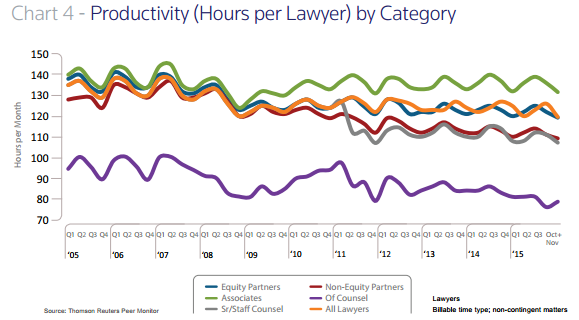You are currently browsing archives for the Data category.
Trends in Law Firm Staffing
Altman Weil has released its annual report on “Law Firms in Transition.” The report, based on a survey of managing partners of law firms with at least 50 lawyers, documents continued change in the way law firms staff their matters.
More than half of these law firms now use contract lawyers (57.1%) or part-time lawyers (52.7%). Almost half (41.8%) employ staff attorneys. Larger firms (those with at least 250 lawyers) are more likely than smaller firms to use these staffing strategies. Indeed, about three quarters of those larger firms use contract lawyers (77.0%), part-time lawyers (71.3%) or staff attorneys (78.2%). The numbers, however, are still significant at firms with 50-249 lawyers–especially for contract lawyers. More than half (50.4%) of the mid-sized firms use those lawyers.
Law firms have adopted these strategies because they increase profitability. Sixty-nine percent of the surveyed leaders indicated that “shifting work to contract/temporary lawyers” has resulted in a “significant improvement” in that metric. Almost half (49.5%) thought that “shifting work from lawyers to paraprofessionals” had the same salutary effect.
Law firms have also started to push the next frontier in staffing client matters: by using artificial intelligence (like IBM’s Watson) for some analyses. More than a third of law firms (36.3%) have started using those tools or “have begun to explore” those opportunities.
These results are not surprising to anyone who has followed law firm trends since the Great Recession. They underline, however, firms’ enthusiasm for these new staffing models.
H/t to TaxProf for noting the availability of Altman Weil’s report.
LST Reports Updated
As Debby pointed out, the ABA just released the latest employment statistics. Each school’s report is on the ABA website and their own website, but it’s not easy to compare schools in a giant spreadsheet, either with each other or year over year. I just updated the LST Reports with all the new data. These comparisons are easy using our tools.
2016 Employment Outcomes
The ABA has posted its report on employment outcomes for the Class of 2016, along with two school-by-school spreadsheets. One of the spreadsheets tracks law school funded jobs that require bar passage; the other details other employment outcomes. My initial take-aways are:
- Nationwide, the size of the graduating class fell 7.15%.
- That decline allowed schools to register a slight increase in the percentage of graduates employed in the key category of full-time, long-term jobs requiring bar admission. That percentage rose from 59.2% to 61.8%.
- The number of graduates employed in those job categories, however, fell from 23,687 for the Class of 2015 to 22,930 for the Class of 2016. That decline (3.1%) continues a trend noted last year, although the decline is smaller this year.
- The number of students taking part-time JD Advantage jobs rose markedly–by 16.3% in the long-term category and 72.8% in the short-term one. The overall numbers are small compared to other job categories, but the jumps are noticeable.
- The percentage of graduates known to be unemployed and seeking jobs declined from 9.7% to 8.8%. Those figures, however, must be read in connection with an increase in the percentage of graduates for whom employment status was unknown. If we assume that just a third of the latter graduates were unemployed and seeking work (a conservative estimate), then 10.04% of the Class of 2016 was still unemployed and seeking work ten months after graduation.
Overall, the report suggests continued weakness in the entry-level job market for law graduates. The decline in the absolute number of graduates holding full-time, long-term jobs requiring bar admission is worrisome–especially since we take that measure a full 10 months after graduation. Even more troubling is the fact that 10% of the nation’s law graduates are unemployed and seeking work a full ten months after graduation.
Jobs and Salaries for New Lawyers
What does the job market look like for new lawyers? The ABA will soon release statistics about the Class of 2016, and NALP will add additional information by the end of the summer. But the Bureau of Labor Statistics (BLS) gives us an advance peak.
Each year, BLS reports job numbers and salaries for a wide range of occupations. This series of reports includes only salaried positions; for the legal profession, the series omits both solo practitioners and equity partners in law firms. Still, since most new graduates seek salaried positions, these numbers offer a useful measure of the profession’s ability to absorb and pay new members.
LSAC Throws a Temper Tantrum
The Law School Admissions Council has thrown its latest tantrum.
In a letter to admissions professionals around the country, LSAC’s president, Daniel Bernstine, signaled that LSAC would stop certifying the accuracy of each law school’s LSAT and undergraduate GPA statistics. The certification is a joint effort between LSAC and the ABA to prevent law schools from lying about their admissions statistics.
LSAC agreed to certify admissions statistics in 2012 after months of roundly dismissing calls for certification. The group had claimed that certification would be cost prohibitive, despite nearly $60 million in total revenue in 2011 and a $10.7 million surplus in 2012. The group also claimed that certification was outside the scope of its organizational mission, despite its member law schools saying that LSAC was best positioned to protect the integrity of the admissions process.
Pressure mounted in 2011 and 2012 for LSAC to help the ABA after two law schools intentionally reported fraudulent data to the ABA and elsewhere, including to U.S. News and World Report for their annual law school rankings. In February 2011, Villanova University School of Law reported that an official at the law school intentionally reported fabricated LSAT and GPA statistics for an unknown number of years prior to 2010. Later that year, the University of Illinois College of Law admitted to intentionally fabricating the same statistics over a seven-year period. The school’s assistant dean for admissions and financial aid, Paul Pless, resigned as a result of the controversy.
This tantrum is LSAC’s second one this year. Both came after the University of Arizona James E. Rogers College of Law announced that the school would allow applicants to submit GRE scores in place of LSAT scores.
At that time, LSAC threatened to strip Arizona of its membership, which would eliminate access to a variety of services. LSAC walked back the threat in May after pressure from its membership and anti-trust concerns.
So why is the ABA now the latest recipient of LSAC’s retribution?
In response to law schools hoping to utilize the GRE as a non-exclusive alternative to the LSAT, which is designed and administered by LSAC, the ABA is examining whether the GRE meets Standard 503. That standard provides that schools must use a “valid and reliable admission test to assist the school and the applicant in assessing the applicant’s capability of satisfactorily completing the school’s program of legal education.” The LSAT is the only nationally validated test as of right now, though Arizona independently validated the GRE and other schools are trying to also.
(more…)
The Seventeen Percent
In a recent column, Professor Stephen Davidoff Solomon observes that the legal job market “is a world of haves and have-nots.” With BigLaw firms raising entry-level salaries from $160,000 to $180,000, he concludes, “[t]op law graduates are doing better than ever.” Conversely, “it is clear that it is harder out there for the lower-tier law schools and their graduates.”
I agree with Professor Solomon about the divided nature of our profession; that reality has haunted American lawyers for decades. Solomon, however, significantly overstates the percentage of law graduates who fall within his world of “haves” (those whose salaries recently climbed from $160,000 to $180,000).
Did Firms Raise Salaries High Enough?
Originally published on Above The Law.
 Deborah Merritt, a law professor at the Ohio State University, published an informative analysis on her blog yesterday about the new market rate salary for large law firms, which has been extensively covered here on ATL.
Deborah Merritt, a law professor at the Ohio State University, published an informative analysis on her blog yesterday about the new market rate salary for large law firms, which has been extensively covered here on ATL.
To her and virtually every other observer, the increase to $180,000 signals that many large firms are prospering. In part the increase reflects a small but steady increase in associate productivity since 2008, reaching roughly the levels from the last market rate increase in 2007. The following chart is from the 2016 Report on the State of the Legal Market, issued by Georgetown Law’s Center for the Study of the Legal Profession:

Associates are continuously more productive by this measure than any other category of worker, although at lower billable rates than partners. Interestingly, the gap in productivity between associates and other groups is significantly greater post-recession.
(more…)
» Read the full text for Did Firms Raise Salaries High Enough?
Caveat Venditor: Throwback To The Days Of Junk Employment Statistics
Originally published on Above the Law
 Welcome to the second installment of Caveat Venditor, a series that assesses claims made by law schools to separate truth from fiction. This week we look at Brooklyn Law School’s employment rate of 92.2% posted on its “By The Numbers” infographic.
Welcome to the second installment of Caveat Venditor, a series that assesses claims made by law schools to separate truth from fiction. This week we look at Brooklyn Law School’s employment rate of 92.2% posted on its “By The Numbers” infographic.
I noticed this claim on Brooklyn’s website after investigating the concern of a prelaw advisor. At the quadrennial Pre-Law Advisor National Council conference, this prelaw advisor asked what to do when a law school does not meet the accreditation requirements by not publishing the required disclosures. Indeed, Brooklyn was publishing an old report nearly six months after the ABA required them to publish its new one. Brooklyn remedied this problem on Monday, citing an “oversight due to transitions in several administrative departments in the last year.” According to a spokesperson from the law school, the ABA did not follow up with the law school to make sure it published the materials on time or at all.
(more…)
» Read the full text for Caveat Venditor: Throwback To The Days Of Junk Employment Statistics
About Law School Cafe
Cafe Manager & Co-Moderator
Deborah J. Merritt
Cafe Designer & Co-Moderator
Kyle McEntee
 Law School Cafe is a resource for anyone interested in changes in legal education and the legal profession.
Law School Cafe is a resource for anyone interested in changes in legal education and the legal profession.
Around the Cafe
Subscribe
Categories
Recent Comments
- on Experiential Education
- on Scholarship Advice
- on ExamSoft: New Evidence from NCBE
- on COVID-19 and the Bar Exam
- on Women Law Students: Still Not Equal
Recent Posts
- Experiential Education
- The Bot Takes a Bow
- Fundamental Legal Concepts and Principles
- Lay Down the Law
- The Bot Updates the Bar Exam
Monthly Archives
Participate
Have something you think our audience would like to hear about? Interested in writing one or more guest posts? Send an email to the cafe manager at merritt52@gmail.com. We are interested in publishing posts from practitioners, students, faculty, and industry professionals.